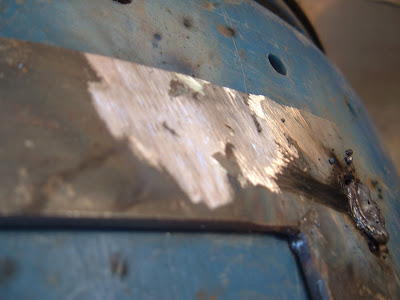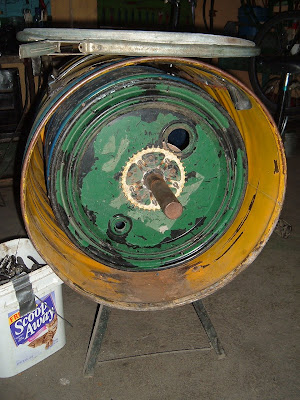.
In the front right corner of the shop sat a defunct lavadora de ropa (washing machine). It got lots of inquiries, but they never seemed to prompt any action from Carlos. And then the BBC lit a fire under his ass.
Around the beginning of March the British Broadcasting Corporation called up to request a telephone interview with Carlos. He was elated. The online article turned into two, then a whole slew of newspaper coverage from national and major papers from all over Latin America- Venezuela, Mexico, Honduras, Bolivia and, of course, Guatemala. All the coverage landed Carlos an invitation to an important national science expo in the capital. It was at this point that the lavadora crept out of the corner to receive some much needed resuscitation.
Carlos set me on the task of piecing it back together. It seemed a lot more straightforward then it turned out being.

What it needed first was to have a metal frame attached to the inner perforated barrel (that being the container for the dirty clothes in question). The metal frame would serve to maintain the shape of the maleable barrel, as well as guide to hold the lid as it slides back and forth.

So i started bending metal to fit the curve of the barrel.

And then welded it together.


Once i had the frame all together i attempted attaching it to the barrel. Carlos suggested that i drill two small holes next to each other, send a 14 gauge wire through, twist it tight and then weld the top of it to the frame. This seemed like a really good idea. The execution didn't pan out though.
The plastic of the barrel wanted to curl inward away from the frame, the frames job being to hold it rigid. But the superheated wire melted through plastic letting it go where it wanted to.

I tried clamping it, which solved the melting/pull issue, but then another cropped up.
In order for the frame to smoothly guide the lid the melted wire would have to be ground down flat.



Some of the ground down wire snapped immediately, and the rest follow with a few strong yanks. Carlos suggested using larger bolts with rounded heads (so that they wouldn't catch any clothes on the inside). His suggestion was right on, the greater strength and larger surface area of the bolts did the trick, no yanking was going to snap them apart.

With the frame securely on, the next thing to do was to bend the lid to conform with the barrel. Apparently sitting in the corner got it bent out of shape.


The next thing was to weld on some small angle iron to hold the lid tight, but allow it to move side to side. This was the rough part.

In order to get this thing to stay on there i really had to mangle it, adding all sorts of clumsy pieces to try to convince it into place. It got uglier and uglier, but after a few hand pull tests it seemed solidly on there. So i put the whole thing back together to give it a go. But first a dead kid from the neighborhood had to be removed.
Just kidding. We left him in there.


The smaller plastic barrel fits inside of a larger 55 gallon metal barrel. On the plastic barrel are attached two poles forming a center axis on which the barrel spins. The pole comes out on one end and is clamped to a chain ring which then is hooked up to the bike.


The other side of the barrel is where the lid goes, a hole was cut into it to give the inner barrel support to spin. (I don't remember exactly how the apparatus holding it in place worked...)


With everything in place it was time to see what it could do. It went for a few minutes, really well actually, i changed speed it kept up fine, it rotated smoothly. And then BUH DUNHK.

No dice. My frankenstein lid didn't hold up to the rotational velocity, which was, of course, much stronger than me pulling on it by hand.
As per ususal, Carlos saved the day, chuckling at my mistakes all the while. "Que es eso?" he would point and laugh.
Once he got it all finished he was SO excited that he ran- seriously he ran- to go get soap to test it out.
In his glee Carlos practically dumped the whole box of powder into the washer. It was an incredibly effective sud maker.






The clothes? Uhh, i guess they were clean.
Aww, los nenos, so adorable.
In the front right corner of the shop sat a defunct lavadora de ropa (washing machine). It got lots of inquiries, but they never seemed to prompt any action from Carlos. And then the BBC lit a fire under his ass.
Around the beginning of March the British Broadcasting Corporation called up to request a telephone interview with Carlos. He was elated. The online article turned into two, then a whole slew of newspaper coverage from national and major papers from all over Latin America- Venezuela, Mexico, Honduras, Bolivia and, of course, Guatemala. All the coverage landed Carlos an invitation to an important national science expo in the capital. It was at this point that the lavadora crept out of the corner to receive some much needed resuscitation.
Carlos set me on the task of piecing it back together. It seemed a lot more straightforward then it turned out being.

What it needed first was to have a metal frame attached to the inner perforated barrel (that being the container for the dirty clothes in question). The metal frame would serve to maintain the shape of the maleable barrel, as well as guide to hold the lid as it slides back and forth.

So i started bending metal to fit the curve of the barrel.

And then welded it together.


Once i had the frame all together i attempted attaching it to the barrel. Carlos suggested that i drill two small holes next to each other, send a 14 gauge wire through, twist it tight and then weld the top of it to the frame. This seemed like a really good idea. The execution didn't pan out though.
The plastic of the barrel wanted to curl inward away from the frame, the frames job being to hold it rigid. But the superheated wire melted through plastic letting it go where it wanted to.

I tried clamping it, which solved the melting/pull issue, but then another cropped up.
In order for the frame to smoothly guide the lid the melted wire would have to be ground down flat.



Some of the ground down wire snapped immediately, and the rest follow with a few strong yanks. Carlos suggested using larger bolts with rounded heads (so that they wouldn't catch any clothes on the inside). His suggestion was right on, the greater strength and larger surface area of the bolts did the trick, no yanking was going to snap them apart.

With the frame securely on, the next thing to do was to bend the lid to conform with the barrel. Apparently sitting in the corner got it bent out of shape.


The next thing was to weld on some small angle iron to hold the lid tight, but allow it to move side to side. This was the rough part.

In order to get this thing to stay on there i really had to mangle it, adding all sorts of clumsy pieces to try to convince it into place. It got uglier and uglier, but after a few hand pull tests it seemed solidly on there. So i put the whole thing back together to give it a go. But first a dead kid from the neighborhood had to be removed.
Just kidding. We left him in there.


The smaller plastic barrel fits inside of a larger 55 gallon metal barrel. On the plastic barrel are attached two poles forming a center axis on which the barrel spins. The pole comes out on one end and is clamped to a chain ring which then is hooked up to the bike.


The other side of the barrel is where the lid goes, a hole was cut into it to give the inner barrel support to spin. (I don't remember exactly how the apparatus holding it in place worked...)


With everything in place it was time to see what it could do. It went for a few minutes, really well actually, i changed speed it kept up fine, it rotated smoothly. And then BUH DUNHK.

No dice. My frankenstein lid didn't hold up to the rotational velocity, which was, of course, much stronger than me pulling on it by hand.
As per ususal, Carlos saved the day, chuckling at my mistakes all the while. "Que es eso?" he would point and laugh.
Once he got it all finished he was SO excited that he ran- seriously he ran- to go get soap to test it out.
In his glee Carlos practically dumped the whole box of powder into the washer. It was an incredibly effective sud maker.






The clothes? Uhh, i guess they were clean.
Aww, los nenos, so adorable.




No comments:
Post a Comment